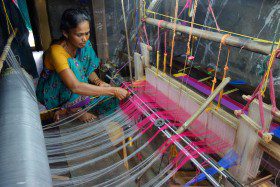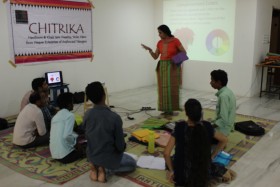This is part a series of organizations in India who received a Social Innovation grant through the SAI/Tata Trusts project on Livelihood Creation.
ORGANIZATION DETAILS
- Organisation Name: Chitrika
- Registered As: Society
- Year Founded: 2005
- Location: Hyderabad, Telangana
- Email: switha@chitrika.org
- Contact Number: +91-944901146
- Website: http://www.chitrika.org/
LEADERSHIP
- Vijaya Switha, CEO
VISION, MISSION AND BROAD OBJECTIVES
Vision
Achieving economic and social well-being of 100,000 artisans by 2020
Mission
Enhancing the livelihoods of the artisans in Andhra Pradesh
Broad Objectives
- Improving financial returns and contributing towards social well-being of artisans
- Developing and resurrecting self-sustaining institutions of artisans
- Providing artisans access to technology, finance, design and market inputs
- Developing human resources for enhancing artisan livelihoods – service providers, professionals and volunteers
- Extending support services to other organizations and institutions working with artisans across India
- Creating and developing common platforms to bring together artisans, their organizations, professionals, service providers and other institutions
- Developing alternatives livelihoods for the artisans
- Advocating better legal and policy environment to support artisans’ livelihoods
CRAFT IN FOCUS
- Name of the craft: Handloom and Khadi weaving
- Key distinctive feature: Contemporary designs and techniques
- Different products that can be made in handloom and Khadi: Sarees, fabric, accessories
- Time taken to make a product of the craft: Six meters can be woven in a day for simple products and one meter can be woven for hand-based buta technique. A saree can be woven in 2 days.
ACTIVITIES AND MODEL OF EXECUTION
Chitrika works directly with weavers by undertaking turnkey projects. It works with the institutions thus created till they become sustainable. It also promotes self-managed and self-sustaining institutions of artisans, aiming to support their livelihood. It aims to support artisans for:
- Improving market realization,
- Reducing drudgery and increasing productivity,
- Reducing risks by improving social security measures and
- Developing self-sustaining institutional aspects.
Currently Chitrika works with two producer companies, one in Srikakulam and another in East Godavari District through its direct outreach program. Apart from direct implementation projects, it undertakes consulting assignments throughout India for reaching more artisans and artisan support organizations.
PRODUCER COMPANIES SUPPORTED BY CHITRIKA
Vamshadhara Weavers’ Producer Company
Vamshadhara Weavers’ Producer Company has 50 active members (total membership 175) and primarily produces Khadi and semi-Khadi products in Srikakulam, one of the most backward districts in Andhra Pradesh. It is well-known for its Khadi and traditional designs like Kupaddaam and Ballakammi. There are approximately 500 handloom households with at least three family members involved in weaving. Chitrika commenced work with establishing four mutually-aided cooperative societies (MACS) in Srikakulam in 2006. These MACS were merged into one single producer company in 2014.
Godavari Women Weavers’ Services Producer Company
Godavari Women Weavers’ Services Producer Company is the first women weaver producer company in India with over 190 women members. It was formed in 2014 and has a vision to reach weavers across the East Godavari District of Andhra Pradesh. East Godavari is home to the most varied weaving techniques and has approximately 3,000 weaver households where women are the main producers of handloom. The place is known for its cotton/silk products, especially ‘Jamdani in silk and cotton’ famously known as Uppada. Weavers mostly weave 80s count with a few skilled enough to weave 100s as well. Chitrika is working in collaboration with ALC (Access Livelihoods Consulting) India in this project.
FUNDING
Currently, Chitrika gets 85 per cent of its funds from consulting assignments it undertakes. The remaining 15 per cent comes from various grants. For the last five years, the Government of Andhra Pradesh has been a major source of funding.
CHALLENGES AND SOLUTIONS
| Area | Challenges | Solutions Implemented |
| 1. Raw Material
| • Mill-control with no bargaining power for weavers • Master weavers control at the local level • Lack of adequate supply of yarn at local level • Supply of local variety of yarn (hand spun) on decline • Increasing exports of cotton | Centralized yarn procurement and arrangement with the mills for price fixation |
| 2. Pre-Loom | • Dwindling numbers due to drudgery • Lack of centralized models for pre-loom processes • Lack of integrated work-sheds | Centralized pre-loom units |
| 3. Weaving | • Lack of quality control standards • Looms requiring upgradation/changes are high | Weaver-level design support, investment in individual loom upgradation and maintenance |
| 4. Post-Loom | • Limited finishing units • Lack of mechanization in stock management/tracking • Lack of value-addition on finished product as end-product price is high | Computerized stock management system and production planning system |
| 5. Marketing
| • Negative perception about handlooms as dated product/limited in choice • Limited range to cater to different segments and occasions | Development products across occasions, age groups and income groups |
| 6. Finance | • Lack of adequate working capital loans • Lack of investment in indigenous technology • Limited/No reach of weavers’ credit card | Internal capital accumulation through savings of members |
GRANT FOCUS: DEVELOPING PRE-LOOM CAPACITY IN THE HINTERLAND
Pre-loom infrastructure and processes consist of: Winding, Warping, Street Sizing, and Warp Dressing. The weak pre-loom infrastructure and facilities in these regions lead to loss of productivity, income and overall potential to scale-up weaving. The current processes also do not give scope for working on huge variety of designs and also standardizing them to ensure quality. With the grant received from Harvard University South Asia Institute, Chitrika invested in developing pre-loom capabilities in these areas by establishing production centers.
A production center rests on centralization of four main processes and one sub-process of bundling the yarn according to the design. The following machines were designed and manufactured with the help of the grant:
- Bobbin winding machines to mechanise winding
- 150 mt warp warping wheel.
Chitrika is experimenting to create production centers to bring efficiency and scale to handloom weaving. Apart from using technology, the idea is to reorganize the production system.
Realizing the Benefits of a Centralized Production Center
The establishment of the pre-loom facilities at the centralized production center led to:
- Performing the functions that were undertaken at the household level in a centralized manner, but near to the weaver
- Reduction in transportation cost
- Improved tracking of yarn and designs
- Local employment generation of 6-7 employees per production center
- Key savings in terms of reduction in the cost of pre-loom, reduction in the transportation cost of Rs.5000 per month, decrease in design errors
In the long run, this model has the potential to give scale, quality and better incomes to weavers. At least five such units will be able to establish the potential of this model.
IMPACT ON BENEFICIARIES
- Increase in average income of weavers of Vamshadhara Weavers’ Producer Company: INR 2500 in 2005 to INR 8000 in 2016
- 100% change in the product portfolio in the last five years in both the producer companies
- Changes in production process through a shift to reactive, azo-free dyes, and high quality yarn
- Employment to ten weaver youth in producer companies
EXPERT OPINION AND MEDIA COVERAGE
- ‘Crafting a new culture’, The Hindu, June 11, 2016
- ‘India’s most promising social enterprises recognised and rewarded at Tata Social Enterprise Challenge 2014-15’, Tata.com, January 20, 2015
- ‘Intellecap Launches Srijan Microfinance Business Plan Competition 2008’, Business Wire India, January 18, 2008




